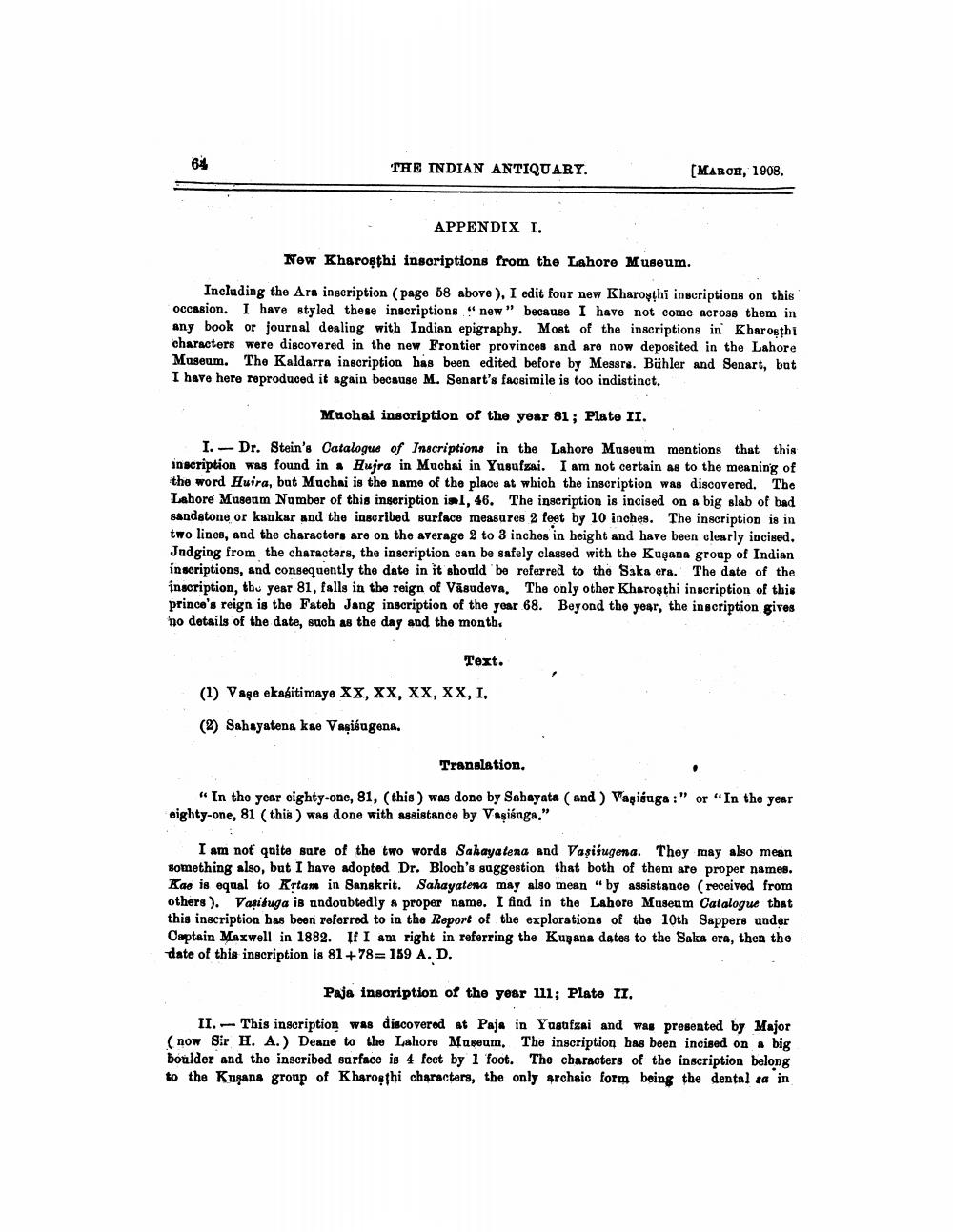________________
THE INDIAN ANTIQUARY.
[MARCH, 1908.
APPENDIX I.
Now Kharoşthi insoriptions from the Lahore Museum.
Including the Ara inscription (Page 58 above), I edit fonr new Kharoşthi inscriptions on this occasion. I have styled these inscriptions “new” because I have not come across them in any book or journal dealing with Indian epigraphy. Most of the inscriptions in Kharosthi characters were discovered in the new Frontier provinces and are now deposited in the Lahore Museum. The Kaldarra inscription has been edited before by Messrs. Bühler and Senart, but I have here reproduced it again because M. Senart's facsimile is too indistinct.
Muohai insoription of the year 81; Plate II.
I. - Dr. Stein's Catalogue of Inscriptions in the Lahore Museum mentions that this inscription was found in Hujra in Mucbai in Yusufzai. I am not certain as to the meaning of the word Huira, bat Muchai is the name of the place at which the inscription was discovered. The Lahore Museum Number of this inscription isI, 46. The inscription is incised on a big slab of bad sandatone or kankar and the inscribed surface measures 2 feet by 10 inches. The inscription is in two lines, and the characters are on the average 2 to 3 inches in height and have been clearly incised. Judging from the characters, the inscription can be safely classed with the Kuşada group of Indian inscriptions, and consequently the date in it should be referred to the Saka era. The date of the inscription, thu year 81, falls in the reign of Vāsudeva. The only other Kharoşthi inscription of this prince's reign is the Fateh Jang inscription of the year 68. Beyond the year, the inscription gives no details of the date, such as the day and the month.
Text.
(1) Vaçe ekakitimaye XX, xx, xx, xx, I, (2) Sahayatena kae Vaşiếngena.
Translation.
"In the year eighty-one, 81, (this) was done by Sahayata (and) Vagisuga :" or "In the year eighty-one, 81 (this ) was done with assistance by Vaşiśnga."
I am not quite sure of the two words Sahayatena and Vaşišugena. They may also mean something also, but I have adopted Dr. Bloch's suggestion that both of them are proper names. Kao is equal to Kitam in Sanskrit. Sahayatena may also mean" by assistance (received from others ). Vasifuga is undoubtedly * proper name. I find in the Lahore Museum Catalogue that this inscription has been referred to in the Report of the explorations of the 10th Sappers under Captain Maxwell in 1882. If I am right in referring the Kurans dates to the Saks era, then the date of this inscription is 81 +78=159 A. D.
Paja insoription of the year 111; Plate II,
II. This inscription was discovered at Paja in Yusufzai and was presented by Major (now Sir H. A.) Deane to the Lahore Museum. The inscription has been incised on a big boulder and the inscribed surface is 4 feet by 1 foot. The characters of the inscription belong to the Kuşana group of Kharop thi characters, the only archaio form being the dental sa in




